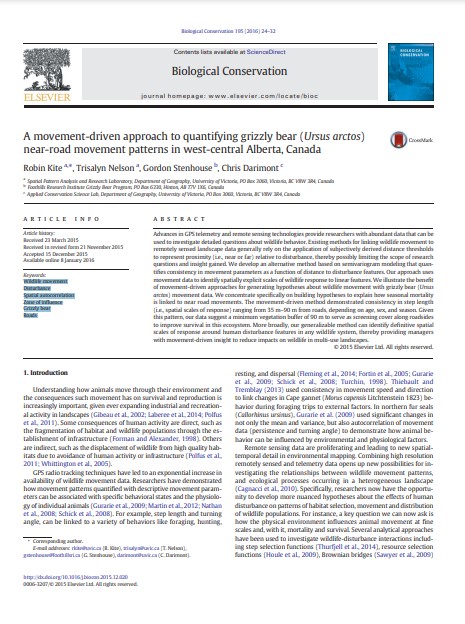A movement-driven approach to quantifying grizzly bear (Ursus arctos) near-road movement patterns in west-central Alberta, Canada.
Bosque Modelo:
Foothills
Temática:
Gestión forestal
Tipo de documento:
Artículo científico
Resumen
Advances in GPS telemetry and remote sensing technologies provide researchers with abundant data that can be used to investigate detailed questions about wildlife behavior. Existing methods for linking wildlife movement to remotely sensed landscape data generally rely on the application of subjectively derived distance thresholds to represent proximity (i.e., near or far) relative to disturbance, thereby possibly limiting the scope of research questions and insight gained. We develop an alternative method based on semivariogram modeling that quantifies consistency in movement parameters as a function of distance to disturbance features. Our approach uses movement data to identify spatially explicit scales of wildlife response to linear features. We illustrate the benefit of movement-driven approaches for generating hypotheses about wildlife movement with grizzly bear (Ursus arctos) movement data. We concentrate specifically on building hypotheses to explain how seasonal mortality is linked to near road movements. The movement-driven method demonstrated consistency in step length (i.e., spatial scales of response) ranging from 35 m–90 m from roads, depending on age, sex, and season. Given this pattern, our data suggest a minimum vegetation buffer of 90 m to serve as screening cover along roadsides to improve survival in this ecosystem. More broadly, our generalizable method can identify definitive spatial scales of response around human disturbance features in any wildlife system, thereby providing managers with movement-driven insight to reduce impacts on wildlife in multi-use landscapes.
Información Bibliográfica
Autor:
Kite, R., Nelson, T., Stenhouse, G., & Darimont, C.
Revista:
Biological Conservation
Año:
2016
N°:
-
País :
Canadá
Páginas:
24 - 32
Volumen:
195
Idioma:
Ingles
Palabras claves
Wildlife movement Disturbance Spatial autocorrelation Zone of influence Grizzly bear Roads





